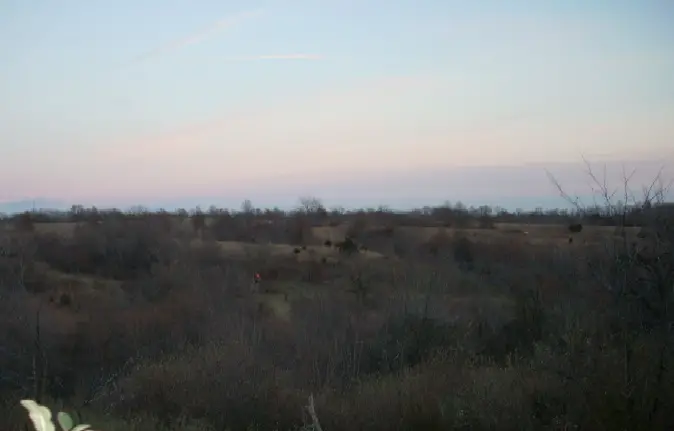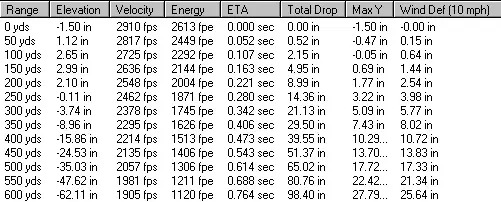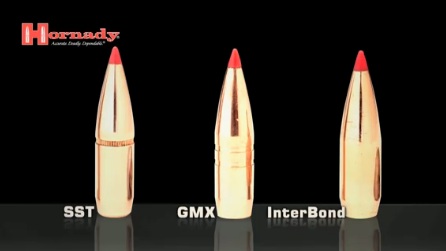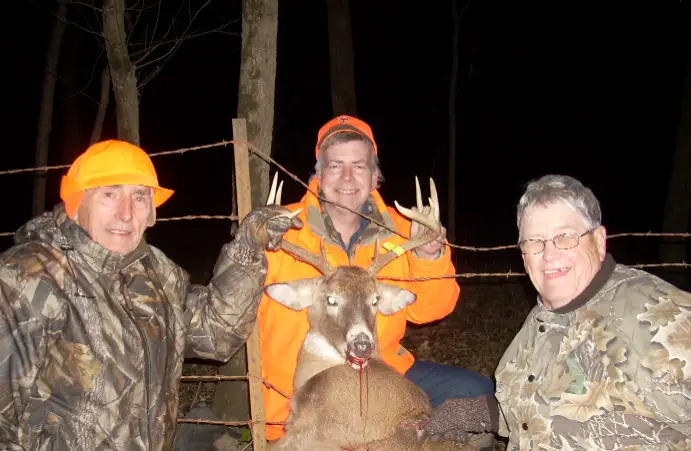


Hornady Superformance and a Missouri Whitetail
The Missouri hunting woods are calling.
Recently, I reported on the outstanding accuracy of the Hornady Superformance 139 grain 7mm-08 GMX cartridge, shooting .5 MOA at 100 yards out of a bone-stock Savage Model 14 American Classic Accu-Trigger rifle. Not only was the accuracy impressive, but the felt recoil out of the seven-pound Savage Model 14 was essentially nonexistent. It is the type of centerfire rifle and load you could shoot all day. Yet, you have an extremely tough high ballistic coefficient bullet that is suitable for most all North American game. It doesn't even feel like you're shooting a high-powered rifle; I found it to be a real creampuff.
Yet, it is a 300 yard MPBR six inch kill zone load with little question. Hornady states the effective velocity range of the GMX bullet is from 2000 fps to 3400 fps. Before you worry about no expansion at 2000 fps, you might consider that you'll never get close to the lower end of the velocity performance envelope in typical hunting situations, as this load doesn't drop below 2000 fps until past 525 yards. Here's an approximation of this cartridge's external ballistics:
November, 2010, brought us to Putnam County, Missouri, to hunt with the always fun-loving Tony Knight and friends. Tony and his wife, Rose, have had a bit of excitement recently, just becoming grandparents again. Son Billy is now "Uncle Bill" for the very first time. Most everything on hooves or claws I've hunted over the last decade or so has been with a muzzleloader. Since I recently had become so impressed with the Hornady Superformance - Savage 7mm-08 combination, I decided to bring it along for Missouri rifle season. I also brought a muzzleloader just in case I had a change of heart. My 82 year old father's first shot out of a Savage 10ML-II several years back resulted in a clean drop of a doe at 225 yards, so Dad has been hooked ever since-- using a muzzleloader more often than not since that day.
Tony Knight has been more influential in promoting muzzleloading hunting than any other individual, to say the very least. But, on opening day we had three muzzleloading fanatics carrying exactly what you wouldn't quite expect. Tony had a M700 Titanium .30-06, Dad had his BAR .270, and I carried the Savage 7mm-08. Most folks that enjoy firearms tend to like all of them; I certainly do. In this case we were carrying centerfires for the "novelty of it," if you can believe that. Variety is the spice, as they say.
It was a windy and rainy drive down to Missouri, with things not looking particularly ideal for opening day. Though cool, windy, with intermittent light rain and drizzle, it still was mild hunting conditions. While we had seen deer the day before, we jumped a couple while setting up blinds the day before, and also came very close to harvesting a big buck on the way down via truck, not much was moving the first morning. It was that way for everyone in camp. The afternoon brought more of the same, but a few shots rang out in the distance as evening approached.
Northern Missouri has some beautiful woods with large tracts of thickly timbered oak. While deer forage for acorns, there are enough row crops planted to keep the venison on the tastier side of the venison spectrum. My secret method for whitetail hunting isn't that complicated of a procedure at all. It is just a matter of hunting in what appears to be a good spot, staying quiet, and staying alert. The more hours in the woods, the better the chances of bagging a decent deer. At least, that's the way it has always seemed to work out.
In the area I was hunting, there were several ravines fingering their way into a well-timbered old river bottom, long ago abandoned. It seemed just ideal, though as the afternoon wore on it seemed more ideal for squirrels than anything else. The radio crackled at about ten minutes to five o'clock, with Tony Knight suggesting that since it was getting a bit dingy in the woods, I might as well pack it in and start making my way out at five or so. That was the idea, but things changed in a minute.
An average buck was making his way towards me in the river bottom, coming from upwind. The buck likely heard the dulcet tones of Tony Knight on the radio, stopping suddenly and staring directly at the blind. Not much for the buck to see except a black hole, so I just waited. After a minute or two, the buck straightened his head out and continued walking past me with a very slow, nervous gait. The Savage went to the shoulder, with the safety coming off as it was mounted. The deer stopped again a moment later, staring once again straight at me. It was a good shot right there, though I was debating whether to take him or not. At that juncture, it would have been sticking the bullet slightly in front of the shoulder, ramming through to shoulder on the off side. I debated, but had a better shooting lane picked out about twenty feet in front of where the deer still stood, still staring at me. The idea was yes, let him straighten out and continue his hesitant walk and whack him broadside when he hit the small opening.
The deer must have heard something from upwind, as he quickly spun 180 degrees and bolted back from whence he came about ten yards, to my right, stopping just as quickly, frozen perfectly broadside. His head was behind oak trees, but I had a clean view of the shoulder. The time for hesitating was over, so I touched off the Accu-Trigger. The Hornady 139 grain GMX blew through the buck like it wasn't there, instantly destroying both lungs. The buck went all of ten yards, if that-- an exceedingly quick, smooth drop for a double-lunger. This deer went to remnants of an ancient, rusty, barbed wire fence that was still partially intact in this river bottom area. Twisting itself in the wire, it looked like the deer was standing on its nose-- because it was. The hind quarters went straight up in the air and the deer came down dead. The picture shows exactly where and how he landed.
I climbed and slid down the ravine and popped the kill tag on the deer. I'd already tried to raise Tony and Dad on the radio, to let them know I'd be a little late. Well, the radios were already dead, so that didn't do any good. Tony Knight is far too polite to refer to me as being completely retarded, I think "diminished capacity" is more the term he would use. I'm not sure if Tony thought I was lost in the eternal Missouri wilderness, or if I had decided to celebrate the end of the hunting day by roasting marshmallows or something. In any case, I hooked up with Dad and Tony as the woods faded into darkness.
Many people have different preferences when it comes to bullet construction. Based on the accuracy and lethality of the tough Hornady GMX, I don't think you can do any better for a "hunt anything" type of projectile.
I couldn't have been more pleased with the performance of the Hornady Superformance 7mm-08 GMX. If you look at the deer, you'll see that he had a sudden, severe attack of "double-lung nose." It was as clean and smooth of a buck harvest as could be hoped for. One of the best things about this combination is the extremely low felt recoil. Hornady Senior Ballistician Dave Emary has discussed how the Superformance ammunition has reduced gas pressure at the muzzle and therefore less "jet-effect" secondary recoil pulse than conventional ammunition. The net result of this is Hornady "Light Magnum" type velocities, but with no more overall recoil than standard loads. I'll happily confess that I have no muzzle exit pressure transducers here at the ready. But I can tell you this is very soft shooting ammunition with no noticeable muzzle jump.
Also impressive, if not astonishing, is the temperature insensitivity of this ammunition. In one battery of tests, from 140 degrees F. to minus 15 degrees F., the velocity difference was only about a hundred fps. Of more relevance is the change from +70 deg. F. to -15 deg. F., showing less than a fifty fps spread. What this means to today's hunter is minimal POI shift from the range to the field. Another feature as noted by Hornady is the trivial velocity loss with shorter barrels, 18 fps per inch going down from 24 inches in one example. This is ideal for many good-handling, short action rifles equipped with 22 inch barrels like the Savage Model 14 American Classic in 7mm-08. The bonus 125 fps MV and the good BC of the GMX translates to 10 - 30 % less wind drift at 300 yards than standard ammunition. That, to me, is a significant benefit. Gravity is wonderfully repeatable and can be easily compensated for. A sudden gust of gravity has never cost anyone a deer, but the same cannot be said for the wind.
For many years, when I've hunted with a centerfire my all-around favorite cartridge has been the .270 Winchester, typically moving a 140 grain bullet in the 2900 fps MV area. With this cartridge, the short action 7mm-08 pulls to within 75 fps or so of the classic .270. Not much can live on the difference, as they say, but if the .270 remains your favorite the Hornady Superformance load bumps it up in concert as well, to 3180 fps or so with a 130 grain GMX. A typical 7mm RemMag 140 grain load hits about 3150 fps, so now it is getting uncomfortably close to the "how many angels can dance on the head of a pin" type debate, one that can be left for another day. The difference between the .277 bullet diameter of the .270 Winchester and the .284 in. diameter of the 7mm falls into the same general pin-dancing discussion, as far as I'm concerned.
If it sounds like I'm impressed with all of this, it is just because I am. I've always preferred higher sectional density hunting bullets which is exactly what you get for the same grain weight .270 vs. a .30-06 or this 7mm-08 vs. a .308. That often means better penetration for a given projectile weight and a higher ballistic coeffecient for a given projectile weight as well. That's free downrange velocity and lethality, free as it means no more recoil and the additional terminal velocity is there due to the higher ballistic coefficient of the bullet. Taking things up a notch with Hornady Superformance ammo means less velocity erosion from pushing wind than a .30 caliber approach, which often means just pushing a poor flying bullet (by comparison) faster. All this, with the performance of "compression loads," but without the recoil, temperature sensitivity, or accelerated barrel erosion. We all have different feelings about recoil, perhaps that's why it is called "felt recoil," but never has anyone tried to make the case that increasing recoil promotes accuracy. It cannot do anything but hinder it.
You can consider this high praise for the 7mm-08 in general and the Hornady Superformance GMX load specifically. A double-lung shot might well be considered a bad scenario for a tough bullet, but the GMX did its job. Collision dynamics are a broad topic: with no two animals truly identical, no two wounds truly identical, there are many variables when two masses collide. When drilling through bone is needed, I'd certainly rather have a tougher bullet to drive through the goodies than a more fragile bullet construction. The Hornady GMX scores big in that department as well: there is little that cannot be swiftly, cleanly taken with this combination . . . from muskrat to moose.
From the left, that's Dad, myself, and Tony Knight. Tony answers to a lot of names: Tony Bill, William Anthony, or just plain Tony. He's better known as the "Father of Modern Muzzleloading" to most and as "Grandpa" to more people all the time. It's hard to beat hunting with Grandpa, particularly if "Grandpa" is Tony Knight . . . and with a new grandson recently arriving, another young man is going to be able to appreciate that. Tony is always smiling, but I think he smiles the most when he is in the woods.
Contact: Randy Wakeman, 12362 S. Oxford Lane, Plainfield, IL 60585
Email: randymagic@aol.com
© Copyright 2003-2010 by Randy Wakeman. All Rights Reserved.






